Cultutre of Plane Surface Configuration
The Japanese Kimono is complete only when a flat fabric is sewn into its configuration and worn with an obi tie. As with the wrapping cloth, Furoshiki, and the washcloth, Tenugui, steric use of the plane surface can be said as a culture unique to Japan.
The Japanese Kimono is complete only when a flat fabric is sewn into its configuration and worn with an obi tie.
As with the wrapping cloth, Furoshiki, and the washcloth, Tenugui, steric use of the plane surface can be said as a culture unique to Japan.
Kimono, including the Yukata, derives from Kosode, a mixture of costumes worn by the noblemen in the Heian Period and by the commons.
Since its characteristics is to return to its plane surface when unstitched, it can be sewn into another new kimono, and people of similar builds can easily share.
Its flat configuration and design has contributed to the growth of unique techniques to dye and weave.
Furoshiki comes in many sizes and can wrap things of various sizes and shapes from big to small, square, round, long and short.
It was first used at baths in the Muromahi Period when Shogun Yoshimitu Ashikaga built a large bath house in his compound in Kyoto and invited Daimyou, feudal lords to entertain.
Fukusa, a square cloth, printed with each lord's family crest marks were used to lay out on the floor underneath them while they changed clothes and to wrap their belongings up while taking baths.
Nowadays, in various sizes from 22.5 to 45 sqcm, Furoshikis are used for carrying, covering, as scarves, or as interior accessories, and are items of necessity at occasions for celebrations and misfortunes.
Patterns vary from family crests to designs for celebrations, beauties of nature and seasons, folklores, and realistic designs of anything around us, creating a culture of its own with its rich variety of plane compositions in Wrapping and tying.
Tenugui is a cotton cloth with a width of nami-haba (about 36cm) and about 1m long, traditionally used for wiping off faces and body during washing and bathing.
Its length was fixed to its present state around the end of the Edo Period when cotton was introduced for its fabric and processing of beautiful dye patterns began.
As in the case of Yukatas, the Chu-sen method to dye in folds was developed in the Meiji Period and has been the main stream up to date.
Since the ends of Tenugui are just cut off and not sewn, they have the characteristic to dry faster than towels.
In recent years, they can be obtained at specialty stores and on line.
The plane cloth is used as handkerchief, twisted into a band and worn around the head at festivals, used for wrapping as in Furoshiki, or framed and hang for interior decorating.
着物の種類とTPO
お宮参り
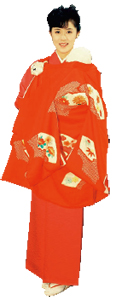 お宮参りは無事に誕生したお礼と、健やかに育つようにという願いを込めて氏神様や守護神に両親と子、祖父母でお参りする風習です。
お宮参りは無事に誕生したお礼と、健やかに育つようにという願いを込めて氏神様や守護神に両親と子、祖父母でお参りする風習です。
最近では、生後男児は31日目、女児は33日目に行われます。
赤ちゃんには祝着(一つ身の二枚襲)を掛け、産後の母体への思いやりから祖母が抱いてお参りする風習になっています。
七五三
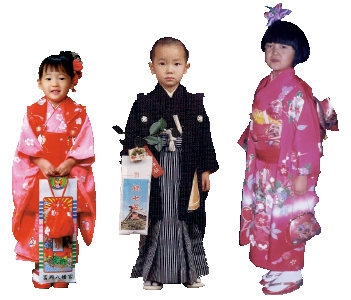 三歳は「髪置の儀」といい、誕生後7日目に産毛を剃り、三歳まで丸坊主で過ごし、三歳の春から髪を伸ばし始めたことからの風習です。長着に付け帯、または長着に被布を着せます。
三歳は「髪置の儀」といい、誕生後7日目に産毛を剃り、三歳まで丸坊主で過ごし、三歳の春から髪を伸ばし始めたことからの風習です。長着に付け帯、または長着に被布を着せます。
五歳は「袴着の儀」といい、男児が初めて袴を着る儀式であり、基盤(人生での勝負を願う意)に乗せ、紋付羽織袴を着装します。
七歳は「帯解の儀」「紐落とし」ともいい、子供は襟の紐をつけたきものから帯を結ぶ本式のきものに着替える祝です。
卒業式
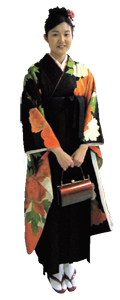 女子大生の卒業式のきもの姿として、色無地に一つ紋、訪問着、振袖の長着に袴をつけた姿が昭和56年ごろからみられるようになり、平成15年のある女子大学の卒業式では卒業生の実に98%が袴を着用し、卒業生の袴姿が定着しています。
女子大生の卒業式のきもの姿として、色無地に一つ紋、訪問着、振袖の長着に袴をつけた姿が昭和56年ごろからみられるようになり、平成15年のある女子大学の卒業式では卒業生の実に98%が袴を着用し、卒業生の袴姿が定着しています。
成人式・結納・披露宴など
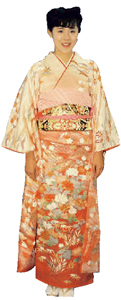 成人式では丹氏は元服で頭に冠を加えることで「加冠の儀」といい、紋付羽織袴を着装し、助詞は見オスの第一礼装としての振袖を着ます。振袖は成人式、結納式、結婚式のお色直しや、御呼ばれで出席する場合の晴れ着として着られています。
成人式では丹氏は元服で頭に冠を加えることで「加冠の儀」といい、紋付羽織袴を着装し、助詞は見オスの第一礼装としての振袖を着ます。振袖は成人式、結納式、結婚式のお色直しや、御呼ばれで出席する場合の晴れ着として着られています。
結婚式
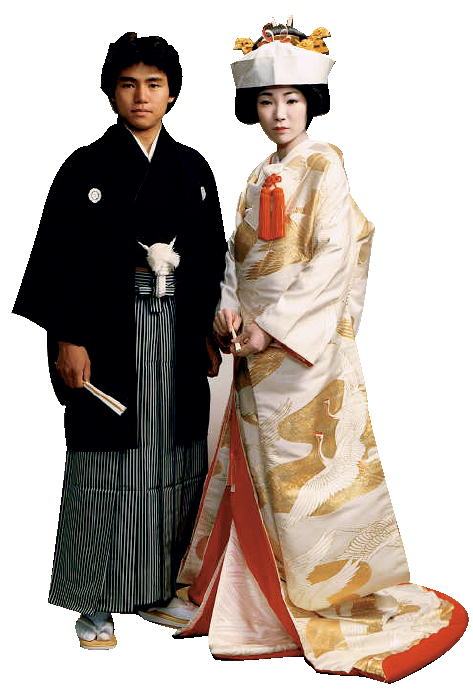 明治、大正、昭和の初期までは花嫁衣装は黒の裾模様の三枚重ね(黒、赤、白)でしたが、昭和30年頃より、打掛姿、色打掛に角かくし、白無垢に綿帽子姿となりました。新郎と新郎新婦の父親も黒の紋付羽織袴姿です。
明治、大正、昭和の初期までは花嫁衣装は黒の裾模様の三枚重ね(黒、赤、白)でしたが、昭和30年頃より、打掛姿、色打掛に角かくし、白無垢に綿帽子姿となりました。新郎と新郎新婦の父親も黒の紋付羽織袴姿です。
新郎新婦の母親はミセスの第一礼装である、五つ紋付の黒留袖を着ます。色留袖はミス、ミセスの例服とあり、五つ紋付は黒留袖と同格になりますが、三つ紋や一つ紋付にして、お茶会パーティーにも着られます。
茶道・観劇
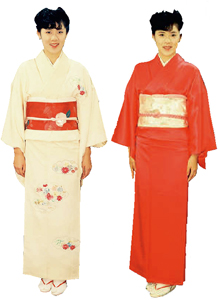 茶席や観劇には訪問着、付下げ、色無地、小紋などが着られます。お茶会は侘び、寂び(質素で落ち着いた趣)の心を大切にして、あまりけばけばしい色合いは馴染みません。観劇は、歌舞伎のお正月公演などは少し華やかな装いが向きますが、国立劇場は新劇の場合は少し気軽な装いがよいでしょう。これらの着ものには帯を袋帯にすると重々しい装いとなり、名古屋帯を合わせると華やかになります。
茶席や観劇には訪問着、付下げ、色無地、小紋などが着られます。お茶会は侘び、寂び(質素で落ち着いた趣)の心を大切にして、あまりけばけばしい色合いは馴染みません。観劇は、歌舞伎のお正月公演などは少し華やかな装いが向きますが、国立劇場は新劇の場合は少し気軽な装いがよいでしょう。これらの着ものには帯を袋帯にすると重々しい装いとなり、名古屋帯を合わせると華やかになります。
葬式
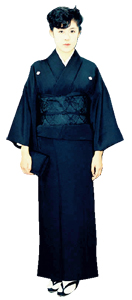
告別式には正装である、五つ紋付きの黒喪服になります。帯、帯揚げ、帯締め、草履、バック全て黒で統一します。また、地方によっては白も服の着用も残っています。
白無地の長着に黒共帯、法事やお別れ会などの略喪服として着られることもあります。
寒い時など
寒くなるとコートや羽織を重ね着します。コートは長コート、班コートがあり、襟も道行襟、都襟、笹襟、千代田襟、きもの襟などがあります。
雨天の時は、雨コートを着用しますが、一部式、二部式などがあります。コートは出かけ先の玄関では脱ぎましょう。雨や雪のときは、底にゴム系のものを使用した透明爪付き草履(ドームカバー付き)、雨雪用草履や、爪掛(爪革)付き下駄を使用するとよいでしょう。
羽織は、室内でも着用ができます。男性の羽織は正装に着用しますが、女性は正式な席では着用せず、帯つき姿となります。
